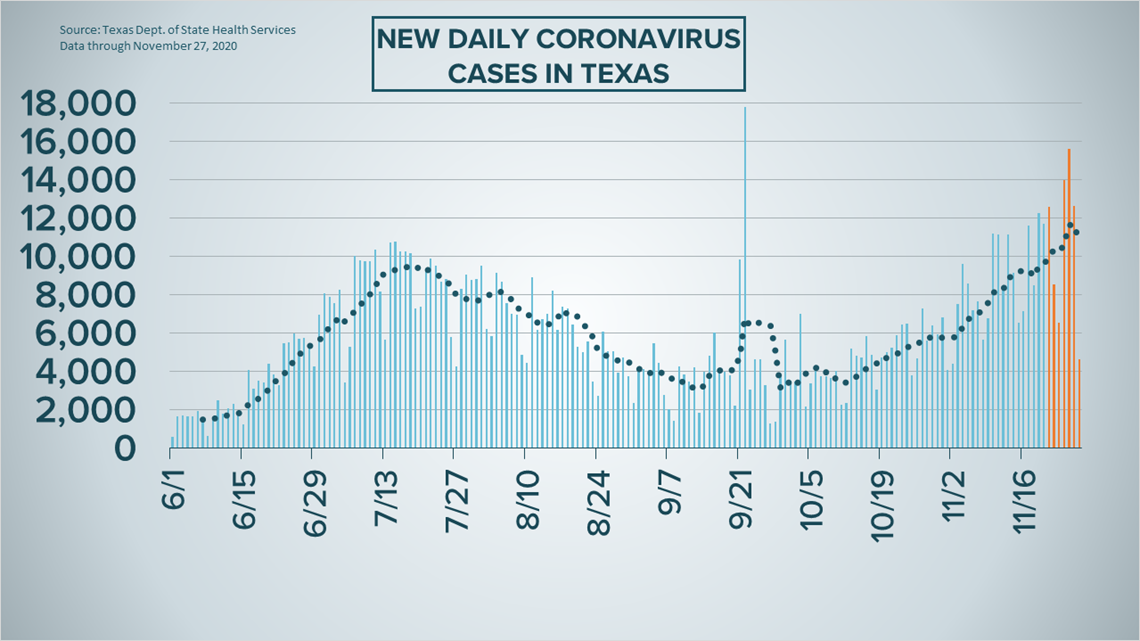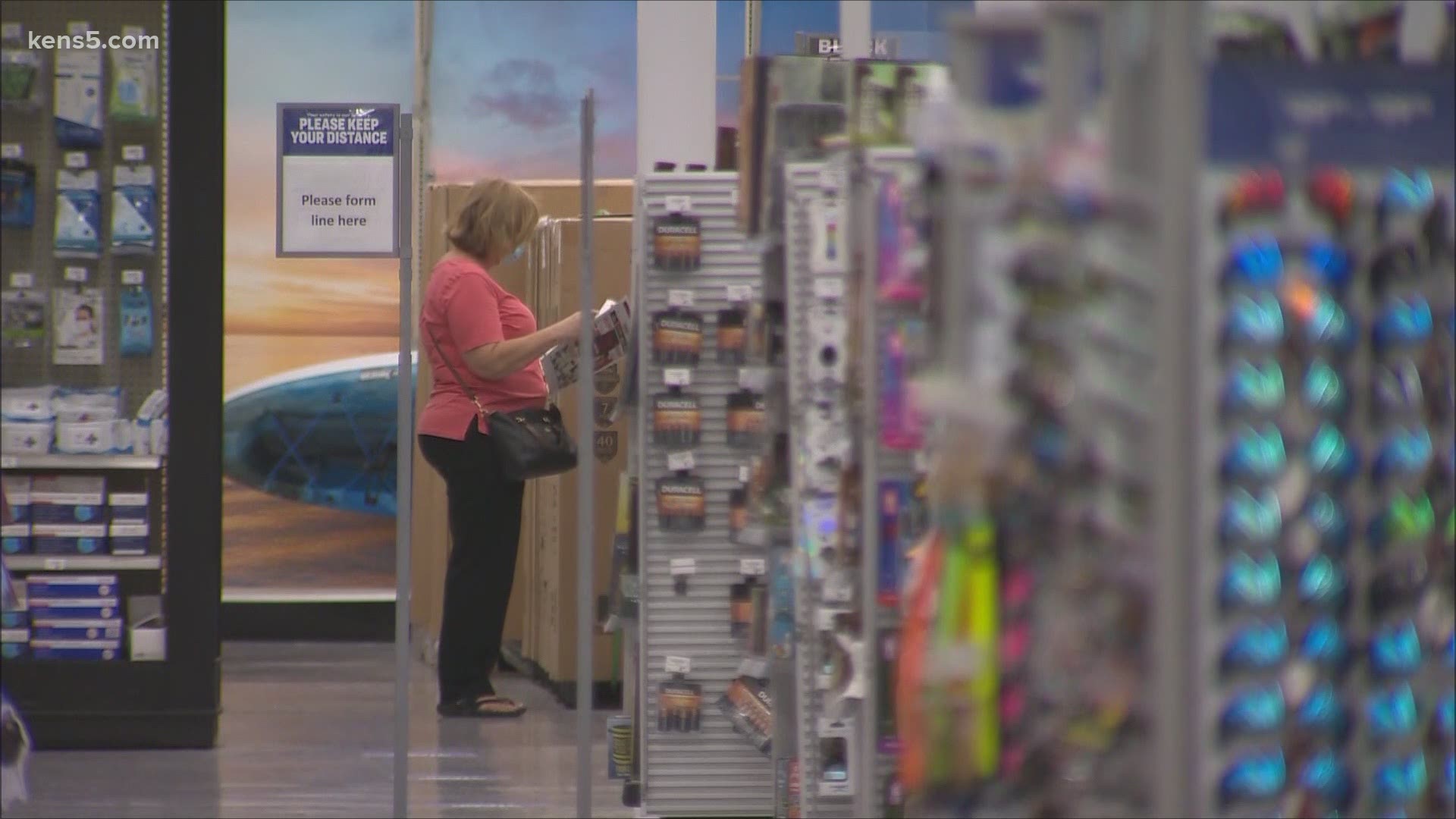SAN ANTONIO — We're tracking the latest numbers from the coronavirus pandemic in San Antonio and across Texas. Here are the latest numbers reported by Bexar and surrounding counties:
- Bexar County: No new figures reported by Metro Health on Friday, due to the Thanksgiving holiday. 1,032 new cases were reported on Wednesday, bringing the total number of cases to 76,750. Six new deaths were also reported Wednesday, raising the death toll to 1,343.
- Comal County: The county reported 41 new COVID-19 cases Friday, and no new virus-related deaths. There have been a total of 4,508 reported cases of COVID-19 in the county – including 3,203 lab-confirmed cases – while 128 county residents have died. County officials say there are 482 active coronavirus cases, and 3,898 residents are considered recovered.
- Hays County: Officials in Hays County on Tuesday reported 55 new cases in the county and no additional COVID-related fatalities. As of Tuesday, there are a total of 7,097 lab-confirmed cases in the county (708 of which are active), while the death toll remained at 99. 6,290 residents have recovered from the virus. The county did not release new numbers Wednesday.
More county case information is available through the Texas Department of Health Services COVID-19 dashboard.
How Bexar County is trending
We've tracked how many coronavirus cases have been confirmed in Bexar County from the time officials began reporting cases in March 2020. The graphic below shows the number of cases since June and charts those daily case numbers along a 7-day moving average to provide a more accurate picture of the overall coronavirus case curve in our area and the direction we're trending amid the pandemic.
Due to the extended Thanksgiving holiday, City of San Antonio officials said no new coronavirus figures would be reported on Thursday or Friday. As of Wednesday evening, however, there have been 76,750 local diagnoses since the pandemic began, while 1,343 county residents have died from virus-related complications.
Updated numbers are expected to be reported by local health officials on Saturday evening.
Coronavirus in Texas
The total number of novel coronavirus cases in the state since the pandemic began grew by 4,630 on Friday, according to the Texas Department of State Health Services—a marginally lower tally than the daily totals reported earlier this week, likely due to fewer people getting tested on Thanksgiving.
That total includes 2,473 new cases, as well as 1,043 cases attributed to backlogs not previously reported in the state's total (more details can be found at the top of this page). In addition, DSHS officials deleted 87 cases from its overall diagnosis count that they said were duplicates.
As of Friday, 1,197,682 Texans have been diagnosed with COVID-19. Of those, 1,147,045 diagnoses are confirmed tests, while another 50,637 are positive antigen tests.


State health authorities also reported 51 additional virus-related deaths on Friday, a lower total after at least 200 deaths were reported on Wednesday and Thursday. At least 21,207 Texans have died from COVID-19 complications.
The number of COVID-19-related hospital patients, meanwhile, fell for the first time since Sunday. The figure was at 8,518 on Friday, a decrease of 188 patients compared to Thanksgiving's numbers. But hospitalization numbers still remain on the upswing, continuing a trend first glimpsed in the Lone Star State nearly two months ago. Since the start of October, Texas hospitalizations have gone up 167%.
Meanwhile, the state estimates that 946,663 Texans have recovered, while 181,793 Texans remain ill with COVID-19.
The latest update from the Texas Education Agency showed that there have been 50,420 cumulative cases among staff and students across the state through Nov. 15. More information can be found here.
The TEA typically releases new data on school cases every Thursday, but not did do so on the Thanksgiving holiday. Officials said the latest numbers will be reported next week.
Latest Coronavirus Headlines
- Fort Worth-based American Airlines readies to ship COVID-19 vaccine
- US passes 13 million COVID-19 cases
- Black Friday offers beacon of hope to struggling stores
- Disney layoffs increase to 32,000 as pandemic ravages theme park business
- Billions of packages will be delivered to US households for the holidays. One expert says millions will be delayed every day
- TSA numbers show Thanksgiving eve travel at less than half that of last year
- Congress braces for Biden's national coronavirus strategy
- In pandemic era's isolation, meaning of 'self-care' evolves
Coronavirus symptoms
The symptoms of coronavirus can be similar to the flu or a bad cold. Symptoms include fever or chills, cough, shortness of breath or difficulty breathing, fatigue, muscle or body aches, headache, new loss of taste or smell sore throat, congestion or runny nose, nausea or vomiting and diarrhea, according to the Centers for Disease Control.
Most healthy people will have mild symptoms. A study of more than 72,000 patients by the Centers for Disease Control in China showed 80 percent of the cases there were mild.
But infections can cause pneumonia, severe acute respiratory syndrome, kidney failure, and even death, according to the World Health Organization. Older people with underlying health conditions are most at risk.
But infections can cause pneumonia, severe acute respiratory syndrome, kidney failure, and even death, according to the World Health Organization. Older people with underlying health conditions are most at risk.
Experts determined there was consistent evidence these conditions increase a person's risk, regardless of age:
- Chronic kidney disease
- COPD (chronic obstructive pulmonary disease)
- Obesity (BMI of 30 or higher)
- Immunocompromised state (weakened immune system) from solid organ transplant
- Serious heart conditions, such as heart failure, coronary artery disease, or cardiomyopathies
- Sickle cell disease
- Type 2 diabetes
The CDC believes symptoms may appear anywhere from two to 14 days after being exposed.
Human coronaviruses are usually spread...
- Between people who are in close contact with one another (within about 6 feet).
- Through respiratory droplets produced when an infected person coughs, sneezes or talks. These droplets can land in the mouths or noses of people who are nearby or possibly be inhaled into the lungs.
- Some recent studies have suggested that COVID-19 may be spread by people who are not showing symptoms.
Help stop the spread of coronavirus
- Stay home when you are sick.
- Eat and sleep separately from your family members
- Use different utensils and dishes
- Cover your cough or sneeze with your arm, not your hand.
- If you use a tissue, throw it in the trash.

